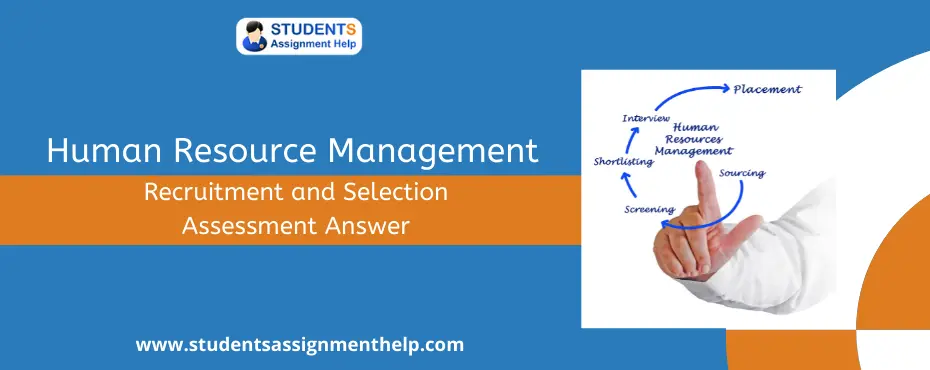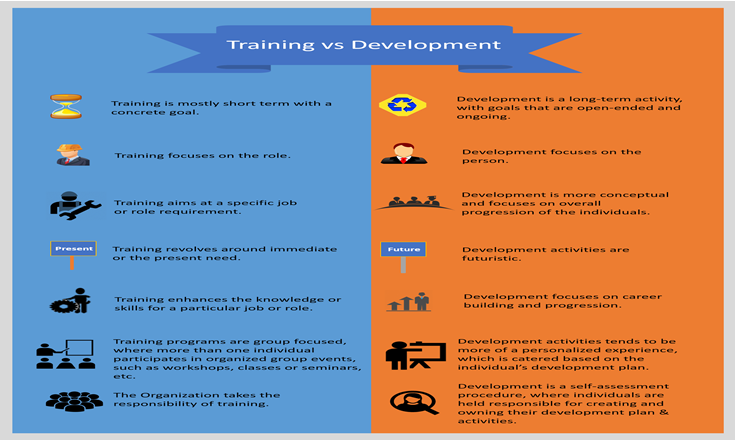UNIT 3: Human Resource Management Recruitment and Selection Assessment Answer

Introduction
The following assignment includes a discussion about workforce planning that plays a vital role in HR management. The work also includes a discussion about workforce planning for Woodhill College. Different approaches to recruitment and section have been discussed in the work along with their strengths and weaknesses. There are other factors considered related to HR management like training programs related to employees, return on investment related to HR factors, and many more.
PART 1 –Recruitment and selection
Task 1
a) Explain the purpose of workforce planning and the role of the HR manager in regard to workforce planning and resourcing for Woodhill College?
The purpose of workforce planning is to provide the organization with the right number of people, with the right skills and competencies, at the right place and at the right time. It is understood as a systematic and fully integrated organization process where HR managers proactively plan for sourcing required talent and appointing it. The workforce planning is based on the premise that a business firm can pose talented personnel only when it proactively forecasts its talent needs and managing supplying accordingly. And, the role of HR manager in workforce planning can be understood as an entity in-charge of working in alignment with the organization’s executives and team members for employing the right number of employees.
About Woodhill College, the HR manager is performing the role of projecting staffing needs, responding it through advertising job vacancies, short-listing job descriptions, interviewing selected candidates, and arranging training and orientation sessions for them. It can be said that the HR manager is responsible for overseeing and evaluating every possible aspect related to talent management. However, it has identified that the HR manager at Woodhill College is working on the principle of the reacting approach rather than being prepared initially (Tan & Nasrudin, 2011).
There is no clear stipulation and implementation of current and future workforce needs as the HR manager strives for filling vacancies when it arises. The element of forecasting talent needs is not present in the workforce planning function of the HR manager of Woodhill College which needs to be improved upon. It is recommended to forecast talent needs on a proactive basis for managing talent inventory avoiding the possibility of shortage or surplus thereby ensuring the smooth functioning of the organization.
b) Explain the strengths and weaknesses of different approaches to recruitment and selection
The different approaches to recruitment and selection are based on reactive and proactive attitude. As the name indicates, the reactive approach requires the organization to reacting or responding quickly to new job vacancies as and when they arise while a proactive approach requires spending time for building a pool of qualified candidates before the new positions are opening up or vacancies arise. In a proactive approach, recruitment personnel believes in investing time and effort in building a pool of qualified candidates before any new position arises or opens up. Flexible Rates Compatible With Everyone’s Budget
In context to Woodhill College, there prevailed a reactive approach as human resource managers advertise teaching positions on the website on arising of job vacancies or new candidates. The main advantage of this method is it is less time consuming as interested candidates who need a job at that time submit their proposal and the interview is conducted accordingly (Boxall & Purcell, 2013). There is no need of spending time creating a pool of qualified candidates initially and shortlisting among them later on. But, this approach is having one disadvantage of difficulty in sourcing qualified candidates as competent personnel are not always available as per the organization’s requirements.
In the same token, a proactive approach is also having certain benefits and risks. The major benefit of a proactive approach is the pool of qualified candidates on a proactive base. The human resource manager is not required to immediately search and source pool of candidates anyhow in a given period. The pool is available already from which final selection has to be done. However, this approach contains the risk of dual efforts means initially for sourcing candidates and selecting later on.
Hire a Professional Essay & Assignment Writer for completing your Academic Assessments
Task 2: Investigate the job role of your choice in the education sector. Find out what skills and qualifications would be needed for this job role.
a) Write a job advertisement for the role
The requirement of Admission Counsellor for a College
- Looking for a candidate ready for giving counseling to parents and children.
- Having good experience in counseling and knowledge regarding education profile.
- The ability of cold calling and gaining the confidence of parents and students.
- Knowledge of preparing daily reports and circular regarding the performance of students and entering it daily or periodic basis.
- Should develop awareness regarding education trends and drives prevailing in the industry.
- Experience in the field of the education sector for providing advice and suggestions accordingly.
Job type: Full-time
Salary: As per industry norms
Required education: Postgraduate degree or diploma
Required experience: Fluent tele calling, communication ability, and sound personality (Mathis & Jackson, 2010).
b) Identify suitable platforms to place the advertisement
The suitable platforms for placing advertisements are print, radio, TV, and the Internet. Under print advertising medium, the job posting is posted in newspapers, magazines, catalogs, and program books for posting requirements, and radio is used where a voice message is employed for giving sound effects to the customers. Thirdly, TV is adopted for targeting audiences and demonstrating the effectiveness of product and service (Keele & DeHart, 2011). This advertisement is highly effective as it helps in catching viewers’ attention and interest. Furthermore, the Internet is viewed as another effective medium where people are using computer screens and smartphones at a high level. Social media tools such as Facebook, Twitter, and other social sites can be used for attracting large users and targeting them on a wider scale.
c) Prepare a job specification and person specification for the role
Job specification: Admission counselors at the college level is having wide array responsibilities of improving the overall visibility of the college among the community and enticing potential applicants. For this, it is expected from admission counselors to pose a wide range of knowledge regarding educational, vocational, and other degree courses appearing interesting to students. The candidates should have a keen willingness in assisting students in providing necessary documentation and another assistance requires for the application process.
Person specification: Must hold Postgraduate degree or diploma with state licensure for working in colleges and universities for communication, organization, and interpersonal skills purpose. Other than this, candidates should have high-level willingness in attending in education fairs and other events for improving learning and understanding regarding teaching and education fields, along with this, pose-ability of preparing and presenting information sessions, strong communication skills, and formulating admission decisions in light of industry trends and scenario.
d) Provide a rationale for the application of specific HRM practices in the context of the above case problem
The HRM practices in the context of the above case problem are based on recruitment, selection, and workforce planning. The adopted practices are rational and perfectly applicable in the above case scenario. It provides insight regarding the manner to which personnel is recruited and employed at Woodhill College. At the selected organization, success and growth primarily depend on the competent personnel and qualification pose by them which again rely on selected HRM practices (Lee & Lieberman, 2010).
Part 2: Employee performance, development, and reward: Case study: TESCO
Task 3 (LO2)
a) Explain the difference between training and development.
Source: http://www.gyrus.com/the-difference-between-training-and-development/
Both training and development are crucial HR activities strive towards improving the existing competency framework of personnel and contributing to the overall growth of the organization. The difference lies in the duration, scope, and purpose of training and development as training is short term activity focussed on developing skills, competency, and knowledge of employees. On the other hand, development is an educational process concerned with the overall growth of the employees.
The duration of the training program is quite a short term while development is for long term purpose focussing on the overall growth of employees. The scope of training programs is to improve the overall work performance of the employees while development aims at preparing employees for future challenges and adversities in an effective manner. Moreover, there is the appointment of a special trainer for conducting training sessions while development is self-directed.
b) Explain how have changes in customer expectations affected Tesco and its need to train staff?
Source: http://www.thisismoney.co.uk/money/markets/article-2106432/Tescos-300m-charm-offensive-Store-improvements-better-customer-service-way.html
The purpose of training is to increased capability and skills at Tesco and changes in customers’ expectations have a direct impact on it. There is a linear equation in consumer expectations and training programs employed by Tesco, any kind of change in consumer expectations bring simultaneous change in designing of the training program. This is so because training programs aim at preparing employees for meeting customers’ expectations therefore any kind of changes in those expectations requires Tesco managers in improving employees’ competency accordingly. At Tesco, a planned and structured approach of training is adopted where training programs are designed by customers’ expectations for enabling organisations in meeting their needs and paving the path of future growth and development (Finney, Lueg & Campbell, 2008).
c) List the methods of training carried out by Tesco.
Both on-the-job and off-the-job training methods are carried out by Tesco. Under on-the-job training method demonstration, coaching, mentoring, and job rotation is used. As the name indicates, demonstration includes showcasing how a particular task or job is done; coaching includes appointing a manager for helping trainees in solving problems and finding solutions.
Thirdly, mentoring includes providing advisory services by an experienced manager to staff members and job rotation is concerned with transferring employees temporarily on different tasks and jobs. Likewise, off-the-job training methods are also used for training employees for acquiring new skills such as team-building, communication, preparing presentations, etc. These training methods are conducted in the form of external courses organized by professional training staff of Tesco at different periods (Evaluating Employee performance. 2012).
d) Describe how training needs are identified.
Training needs are identified in light of four contexts at Tesco such as organization, task, performance, and person. In the context of the organization, it is analyzed whether employees are capable of solving business problems effectively and intervening solutions. Secondly, the HR manager also analyses and monitor learning style, level of existing knowledge on the subject, the competence of employees for responding and handling policies, procedures, and trends effectively. In this context, the analysis of tasks is also necessary for analyzing duties and job requirements. The training manager analyses whether personnel is capable enough to fulfill the task responsibilities and duties or facing any kind of problem which needs to be solved through training programs. Lastly, identification of the need for a training program is also done in light of performance context means whether employees are performing by the established standard (Human resource management: managing employee performance, 2012). It is analyzed in detailed terms whether the performance of employees is below expectations or average. The performance below expectations outlines the need for a training program for fostering relevant skills and capabilities among employees by the nature and content of the job.
e) Evaluate the benefits for Tesco and the employees in providing a structured training program.
The structure training program is beneficial for both employees and Tesco as it is an adaptable process where individual employee needs are identified and training programs are designed accordingly. This approach develops confidence among employees as they are visualized as potential candidates having the capability and desire of doing something bigger and different. On the other hand, it also provides a pool of motivated and encouraged employees to training managers which is quite easier to lead and direct (Schermerhorn, 2011). The benefits of a structured training program enable organisation in conducting options programs, a developmental program, and specialized programs. The conduction of different training programs is possible only when employees and managers and employees are working in an aligned manner. This is so because these programs are providing comprehensive knowledge to the personnel thereby benefiting organizations in the short and long term.
f) Indicate the extent to which you think the training has achieved a Return on Investment
The training has achieved an adequate return on investment for the selected organization. For evaluating return on investment, personnel of the organization is carefully monitoring and conducting feedbacks at regular intervals. In this way, it has identified that Tesco adopts an informal approach through reviewing and analyzing employees via a feedback mechanism. The feedback gathered by employees is carefully monitored and scored for analyzing whether training programs are providing an adequate return on investment. It is believed that analyzing whether training programs are yielding an adequate return on investment can be ascertained through employees (Wilton, 2013). For this purpose, the feedback mechanism is employed for asking employees whether they are satisfied with the prevailing training programs or need further improvements. The employees are the entity to which training programs are implemented upon therefore it is pertinent to ask and review employees regarding the effectiveness of the training programs.
g) Suggest the types of approaches to the flexibility that can be adopted by Tesco to aid its expansion of the business.
The different types of approaches to the flexibility that can be adopted by Tesco are advancing technologies, new societal values, changing demographics pattern, and flexible working arrangements. In detailed terms, Tesco should embrace new technologies for creating improved working styles in the organization and empowering employees in managing working styles and time more effectively. The advancement in technologies is disrupting hierarchies and laying down new platforms for employees collaborating and coordinating them in an improved manner.
Besides, there is also an embracement of new societal values for allowing employees to work and developing new skills. The new societal values made employees learning how to live an empowered life without any support from their parents. Last but not least, it is also advisable that Tesco can employ different flexible arrangements like part-time working, job sharing, variable hours, etc for allowing employees to work in a more leverage environment (General & Sergio, 2011).
Buy high-quality essays & assignment writing as per particular university, high school or college by UK, USA & Australian Writers
PART 3 – The employment relationship
Task 4:
a) Provide analyses on the importance of ITV to maintain good employee relations and how it influences their HR decisions as a result.
For ITV, it is highly crucial for maintaining good employee relations in terms of developing shared working culture, creating organization a happy place of working, discouraging possibilities of conflicts, and reducing the problem of absenteeism. In detailed terms, ITV can project and position the organization as a happy place to work through enabling individuals working in focussed and concentration manner. Their mind is not diverted in any kind of tension and stress as a good relationship environment leads them to share and discuss things with each other resulting in automatic evaporation of tensions and stress (Muna & Zennie, 2011).
The workplace is a setting where numerous people are spending high working hours and working non-stop spending the majority of time at the workplace. Therefore, it seems necessary for them to have an enduring working environment where they can share their views and opinions. It is also believed that improved employee relations also foster ITV in discouraging conflicts and issues of absenteeism at the workplace. This happens as employees learn to adjust more and cooperate instead of finding faults (Armstrong, 2012). They waste less time in involving in conflicts and disputes instead treat each other as good friends thereby respect them and learn to compromise and adjust. And, it is said that when employees can do their work in a focussed manner they start liking their work and coming to the workplace daily. They avoid the practice of taking frequent leaves as they enjoy their work and stop complaining to each other.
There is a direct impact of employee relations on decisions of HR as policies regarding performance evaluation, conflicts resolution, etc are framed by it. For instance, the HR department of the concerned organization needs to pay high attention to establishing conflict resolution policies in casework is not having an enduring relationship environment.
On the other hand, there is no need to pay high attention and allocation of resources for conflict resolutions in case employees are happy with each other and working in a fostering environment. Likewise, the performance evaluation policy also takes into account designing and the introduction of several new bonuses, schemes, and benefits on the prevalence of smooth employee relationships in the organization. This is so because it is believed that the performance of employees would surely be above standard as they are highly motivated, focussed, and concentrated allowing them to reach a new ladder of success and growth (Hegar, 2011).
b) Identify and briefly explain the key elements in the employment legislation and how it influences ITV’s HR decisions. Please try to provide examples.
There are several key elements in employment legislation such as individual employment relationship, employment, wages and remuneration, working conditions, trade unions, and industrial relationships, health, safety and welfare, and social security. All these elements of employment legislation influence HR decisions of ITV considerably. For instance, the individual employment relationship aspect ITV’s HR manager to provide policies regarding the transfer, promotion, compensation, and dismissal procedures. It should not be in implicit terms as it gives rise to legal implications therefore should be expressly defined (Jetson & Nelis, 2012).
There should be no vagueness regarding employment relations for avoiding any kind of confusions and conflicts. The second example can be provided in context to employment where HR policies should be clearly defined regarding vocational training, recruitment, placements, apprenticeship, and other unemployment benefits. The main reason behind stipulating the employment aspect in clear terms is to reduce legal litigations and preventing chances of violation of any employment laws. This is the reason that HR policies regarding unemployment benefits and labor protection are framed for restoring the benefits and rights of employees.
The impact can also be identified in wages and remuneration policy of ITV where wage conditions, proper valuation and payments methodology, fringe benefits, minimum wage arrangements, etc are laid down instead of employment legislation. The main notion of ITV HR policies regarding this aspect is to duly respect employees’ wages and compensation rights and ensuring that no employees have been violated on account of minimum wage policy (Minner, 2012). Furthermore, working conditions policy is also designed and implemented by employment legislation. HR policy regarding working conditions is concerned with defining working hours, vacations, the prohibition of child labor, employment of women, regulation of the young population in employment, etc.
In recent years, it has also identified that the ITV HR department is paying high-level attention to providing legal assurance regarding equal employment and pay along with the provision of adequate facilities to employees is duly covered in HR policies. The employees are highly seeking working conditions allowing them to pay attention to family responsibilities like adequate maternity protection, child care homes, etc (Singh, 2012). These provisions are also being included in the HR policy of the respective organization in recent years due to high-level attention and focus on the part of employees on these aspects. Trade unions and industrial relationships emerge as another crucial aspect of employment legislation requiring business firms to formulate and implement policies for the same. ITV HR department or function is no longer exception to it and requires to duly comply with the aspect and formulating policies adequately fulfilling the criteria of trade unions and industrial relationships (Muna & Zennie, 2011).
Health, safety, and welfare also gain adequate attention in recent years on account of large numbers and cases of accidents and injuries. There is pressure from both government and employees side on the business firms to include adequate provisions regarding health, safety, and welfare. In this regard, ITV has also paved a step ahead in the process and formulated HR policies addressing health, safety, and welfare aspects adequately. As per this aspect of employment legislation, HR managers of the organization are required to establish adequate preventive provisions for hazardous occupations such as mining and construction field having the possibility of causing any negative impact on employees’ health and safety.
Besides, it is also mandatory on the part of business firms to place adequate mechanisms for checking the use of chemicals and other harmful substances having chances of affecting employees’ health negatively. Last but not least, social security has also gained attention among HR managers of ITV to pay attention. This has emerged as employers are considered as having a moral obligation for providing comprehensive schemes in terms of income security, employment injury, maternity leave, medical care, and other benefits for widening coverage of social security (Shell & Bohlander, 2012).
Conclusion
From the above analysis, it can be concluded that human resource management is the most vital part of any organization in the current dynamic business environment. It plays a major role in the growth of any organization, it has the power to either collapse the company or show it an accelerated growth path too. From the above discussion it can be said that the training and development of employees are vital in today’s competitive world, and the role of HR is important as it is related to the investments in manpower.
Stuck with a lot of homework assignments and feeling stressed ?
Take professional academic assistance & Get 100% Plagiarism free papers
References
Armstrong, M. 2012. Armstrong’s Handbook of Human Resource Management Practice. Kogan Page Publishers.
Boxall, P. & Purcell, J. 2013. Strategy and Human Resource Management. Journal of ILR review, 57, (1).
Evaluating Employee performance. 2012. [online]. Available at: http://www.fsa.usda.gov/FSA/hrdapp?area=home&subject=mgrs&topic=eep [accessed on: 3rd February 2017].
Finney, R. Z, Lueg, J.E. & Campbell, N.D. 2008. Market pioneers, late movers, and the resource-based view (RBV): A conceptual model. Journal of Business Research 61(9): pp. 925-932.
General, L.M. & Sergio, R.P. 2011. Managing Talent for Competitive Advantage: Perspective from Gulf Cooperation Council Nationals. International Peer Reviewed Journal. Vol. 1.
Hegar, K. W. 2011. Modern Human Relations at Work. Cengage Learning.
Human resource management: managing employee performance. 2012. [online]. Available at: http://crhsculturel.ca/hrtools/pdfs/E_Performance.pdf [accessed on: 3rd February 2017].
Jetson, J. & Nelis, J. 2012. Management by Process. Routledge.
Keele, D.M. & DeHart, S. 2011. Partners of USEPA climate leaders: an event study on stock performance. Business Strategy and the Environment 20(8): pp. 485-497.
Lee. G, K. & Lieberman, M.B. 2010. Acquisition vs. internal development as modes of market entry. Strategic Management Journal 31(2): pp. 140-158.
Mathis, R.L. & Jackson, J.H. 2010. Human resource management. Cengage learning.
Minner, J.B.B. 2012. Role Motivation Theories. UK: Routledge.
Muna, F. & Zennie, Z. 2011. Developing Multicultural Leaders: Journal of The Journey to Leadership Success. Palgrave Macmillan, pp.87-98.
Muna, F. & Zennie, Z. 2011. Developing Multicultural Leaders: The Journey to Leadership Success. Palgrave Macmillan.
Schermerhorn, J.R. 2011. Introduction to Management. John Wiley & Sons.
Shell, S.A. & Bohlander, G.W. 2012. Managing Human Resources. Cengage Learning.
Singh, H. 2012. Training and Development: A Prominent Determinant for Improving HR Productivity. Journal of International Conference on Management and Education Innovation, 37. pp. 274-278.
Tan, C.L. & Nasrudin, A.M. 2011. Human Resource Management Practices and Organizational Innovation: Assessing the Mediating Role of Knowledge Management Effectiveness. Electronic Journal of Knowledge Management 9(2), pp. 155-167.
Wilton, N. 2013. An Introduction to Human Resource Management. SAGE.




